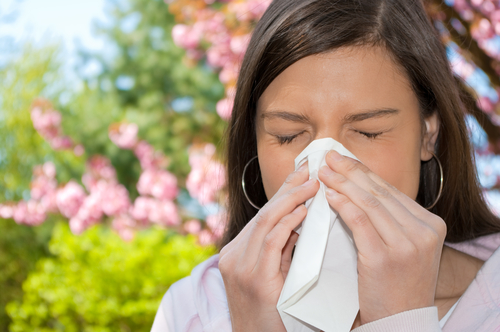Sneezin' Season
If you suffer from springtime allergies, take heart: there are many ways to find relief.

After the brutality of this year’s winter, most of us were eager to trade our snow shovels in for garden spades. But while warm-weather outdoor activities are refreshing, the sun-splashed days of spring and summer also spell misery for seasonal allergy sufferers.
“A seasonal allergy is a response to an allergen that only appears during a particular time of the year,” says Ellen Sher, M.D., an allergist at Atlantic Allergy, Asthma & Immunology Associates in Ocean. While perennial allergies occur year-round and are sparked by indoor pests like pet dander, dust mites and mold, the culprits that cause pain from mid-March through the summer months are all found outdoors. “In the early spring, in our part of the world, tree pollen is the prevalent source of trouble,” says Dr. Sher.
As trees such as birch, maple, oak and poplar start to flower, they release into the air a powder we call pollen. When it’s inhaled by someone who is sensitive to that particular allergen, he or she will experience seasonal allergic rhinitis— more commonly known as hay fever. This inflammation of the nasal airways affects more than 35 million Americans, making it one of the most common chronic diseases, according to the American Academy of Allergy, Asthma and Immunology (AAAAI).
Trees in the Northeast typically release pollen only from March to June. The bad news? Grasses kick into high gear by the end of April, giving sufferers a dose of both tree and grass pollen at the same time. “Ragweed is one of the heaviest pollinators of all allergenic pollenproducing plants, and it pollinates from the middle of August until mid-November or first frost,” says Dr. Sher.
Then there are molds, which grow when it is warm and damp, such as in spring thaws and on humid summer afternoons. Regardless of the trigger, seasonal allergic rhinitis symptoms are the same. “They can include sneezing, nasal congestion or a runny nose, a scratchy throat, red or runny eyes and itchiness of the ears, eyes and nose,” says Fuad Baroody, M.D., chair of the AAAAI’s Rhinitis, Rhinosinusitis and Ocular Allergy Committee. The amount of pollen in the air determines how severe one’s suffering will be. “Certain highly allergic individuals may even experience respiratory problems, like asthma or wheezing,” says Dr. Baoody.
The first thing to do is limit your exposure to pollen. “You can figure out how high the day’s pollen count will be by tuning in to your local weather station or checking the newspaper,” says Dr. Sher. “When you’re inside, you certainly don’t want to breathe in pollen because the more you are exposed to it, the less tolerance you’ll have. So keep the windows closed and run the air conditioner at all times.” Because trees, grasses and weeds generally emit pollen from 5 a.m. to 10 a.m., postponing outdoor activities until af ternoon is a good idea.
“I also ask my patients to shower in the evening, after exposure to pollen,” adds Dr. Sher. “That way you’re washing the pollen out of your hair and off your body before you sleep. Finally, you should change your clothes right after you come indoors and wash them to remove any last traces of pollen.” Of course, none of us can exist in a bubble. If precautionary measures fail, it’s time for treatment. “There are three classes of medication seasonal-allergy sufferers can try,” says Dr. Baroody. Here’s how they break down:
Antihistamines
Available by prescription or over the counter, these pills and nasal sprays block the action of histamine, a body chemical responsible for producing the irksome symptoms associated with allergies. “Antihistamines can be very effective for relieving itching and sneezing, but they don’t offer full runny-nose control,” says Dr. Baroody. And while certain newer antihistamines such as Claritin and Zyrtec (both available over the counter) are non-sedating, many of the first-generation agents like Benadryl will cause drowsiness. “That’s problematic because it can affect job performance and driving ability,” says Dr. Baroody.
Leukotriene Receptor Antagonists (LTR s)
Instead of blocking histamines, these drugs block leukotrienes, another inflammatory chemical released by the body after it is exposed to an allergen. Besides relieving sneezing, itching and congestion to a similar degree as the antihistamines, LTRs such as Singulair (available by prescription) can also clear nasal congestion. Another bonus? “They’re non-sedating, and they’ve even been approved by the FDA for preventing asthma,” says Dr. Baroody. “Yet because they’re more expensive than the antihistamines, they wouldn’t be my first choice of medication to prescribe.”
Intranasal steroids
“By and large the most effective medications we have for controlling allergic rhinitis, nasal steroid sprays like Flonase have none of the side effects people typically worry about when taking steroids,” says Dr. Baroody. “There is no risk of becoming addicted to them, and they don’t make you fat or cause hair to grow where it doesn’t belong.” In fact, the worst result is typically an irritated nose. Five to 10 percent of users may experience dryness or bleeding, but even those problems often can be resolved by switching to a different preparation.
Immunotherapy
Immunotherapy (allergy shots) is often the last course of action a patient will pursue. Each shot contains enough of a specific allergen to stimulate the immune system, though not so much that it will cause a full-blown reaction. Though it’s extremely effective in treating seasonal allergies, immunotherapy does require a major time commitment. Injections must be administered once or twice a week for the first three to six months, so that the body can become accustomed to increasing allergen doses. Once an optimum level is achieved, two to four weeks can pass between doctor visits. Most patients receive immunotherapy for three to five years, af ter which time symptoms are generally mild enough to cease treatment or switch to medication. “A lot of people think of allergies as just a runny nose that can be ignored, but allergies can actually lead to serious complications,” says Dr. Sher. “The bottom line is, allergies are no joke. The good news is that these days nearly 99 percent of all cases can be treated.”



